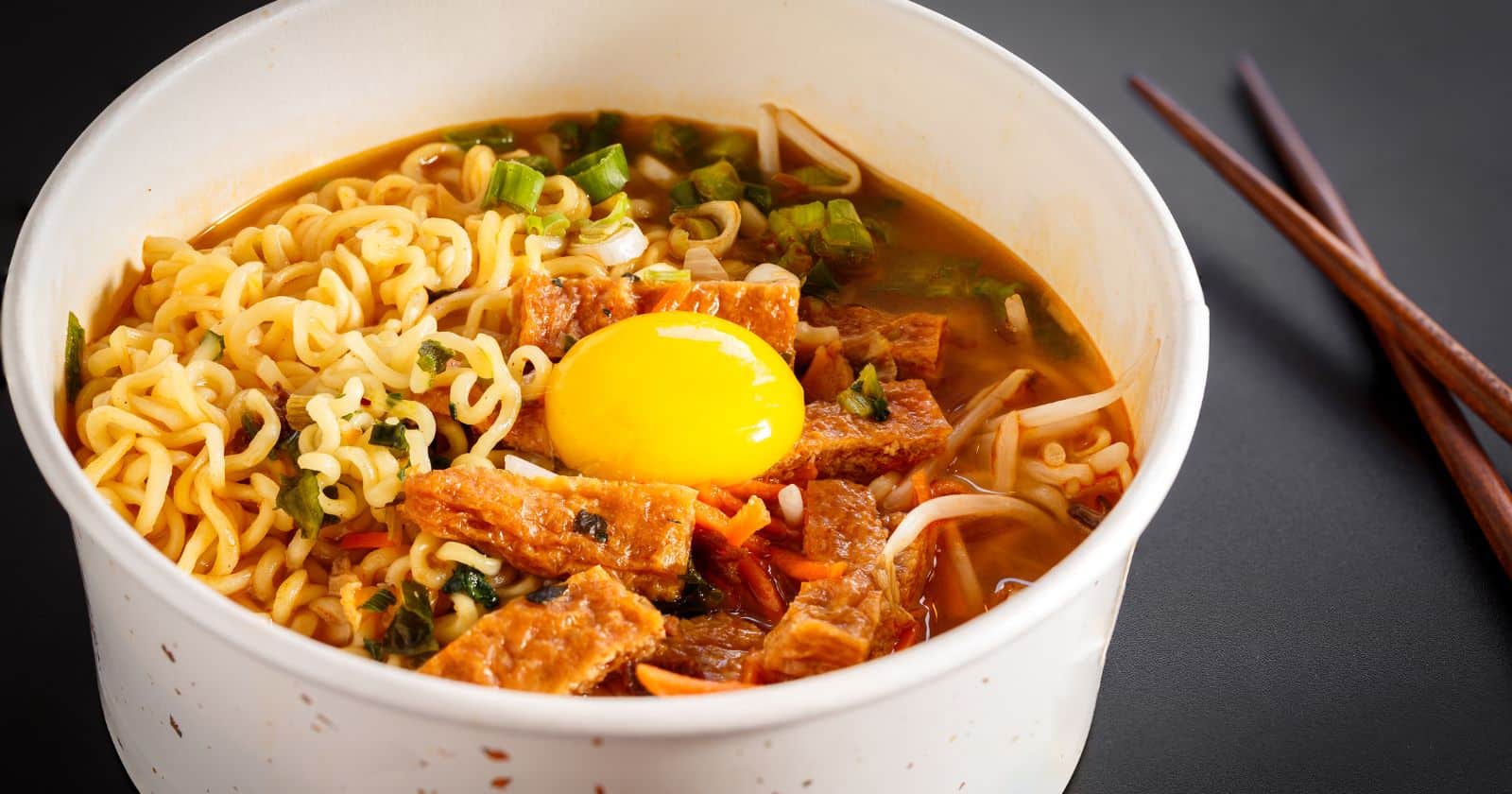Boring old instant ramen is begging for an upgrade. Luckily, there’s one simple trick to take it from bland to gourmet – crack a raw egg right into the piping hot broth! This easy addition instantly amps up flavor, texture, and nutrition for next-level ramen.
You may be wondering, is it truly safe to put a raw egg in ramen? Rest assured, the heat from the broth cooks the egg, making it perfectly safe to consume. Beyond safety, raw eggs offer immense benefits to ramen:
- Extra velvety richness and body
- A boost of protein for staying power
- Added nutrients like vitamin A and selenium
- Deep, savory umami flavor
Adding just a single raw egg brings instant ramen to new taste heights. Read on to learn the proper technique, creative recipes, and alternative cooked egg topping ideas to become a ramen egg pro. Say goodbye to boring noodles and hello to flavorful ramen creations!
Is it Safe to Add Raw Egg to Ramen?
Yes, you can safely add a raw egg to instant ramen! The piping hot broth cooks the egg quickly once added. The result is a creamy, rich flavor and luscious texture that clings to each noodle.
As the egg cooks, the proteins set into solid ribbons that add body and velvety smoothness to the broth. The egg imparts a sweet, umami flavor that perfectly complements the salty noodles.
When handled properly, the health risk of consuming a raw egg in ramen is very low. The heat from the broth is sufficient to cook the egg and destroy any potential bacteria.
Using very fresh, high-quality eggs from a reputable source further minimizes risk when adding raw egg to hot ramen.
The Benefits of Adding Raw Egg
Beyond making your ramen taste incredible, adding a raw egg provides some nice health benefits:
Extra Protein
A large egg contains about 6 grams of high-quality protein. This helps make the meal much more filling and nutritious.
Added Nutrients
Eggs provide vitamin A, selenium, riboflavin, and choline. The egg makes an otherwise nutrition-poor meal more balanced.
Creaminess
The egg adds a rich, velvety consistency that coats each noodle, making the broth feel luxurious.
Flavor Boost
Eggs have a naturally sweet, umami taste that enhances the overall flavor of the dish.
Easy Way to Upgrade
It only takes a minute to transform boring noodles by simply cracking an egg right into the pot!
How to Properly Add Raw Egg to Ramen
Adding a raw egg is simple, but using the right technique ensures the best results. Here are a few methods to try:
Crack Egg Right Into the Pot
For the easiest method, simply crack the raw egg directly into the pot of boiling ramen broth and noodles. Stir gently until the egg ribbons cook, about 1-2 minutes.
Lightly Beat in Separate Bowl
Beat the egg lightly in a small bowl with a fork before slowly pouring it into the boiling broth. Stir to distribute evenly.
Poach on Top
For the perfect poached egg, remove the pot from heat and slide the raw egg onto the noodles. Cover for 1 minute to lightly cook the egg.
Add Flavor Boosters
Add a dash of rice vinegar, soy sauce, sesame oil, or hot sauce to the egg to impart extra flavor.
Handy Tips for the Best Results
Follow these tips for adding egg to ramen flawlessly:
- Use the freshest eggs possible for food safety.
- Reduce heat to low-medium once egg is added to prevent overcooking.
- Stir the pot gently in one direction to create long egg ribbons.
- Add any extras like scallions or chili paste to the egg before pouring into the broth.
- For a soft yolk, cook the egg less time. For firm, cook longer.
- Sprinkle grated parmesan or everything bagel seasoning on the egg for even more flavor.
Creative & Delicious Raw Egg Ramen Recipes
Raw egg provides the perfect creamy base to build all kinds of inventive ramen dishes. Try these unique recipes:
Kimchi Ramen
Stir freshly cracked egg into the broth along with kimchi, sliced pork belly, scallions, and sesame oil.
Carbonara Ramen
Mix egg with parmesan and black pepper, then toss with hot ramen noodles to create a Japanese carbonara hybrid.
Crispy Bacon Ramen
Top ramen with poached egg, crispy bacon crumbles, onion, parsley, and creamy hollandaise sauce.
Tater Tot Ramen
Poach egg in ramen broth and serve over noodles mixed with tater tots, corn, chili sauce, and cilantro.
Egg Drop Miso Ramen
Whisk together egg and miso paste, then drizzle slowly into hot broth while stirring to form egg drop soup-style ribbons.
Food Safety Tips for Raw Egg Ramen
Consuming raw or undercooked eggs does carry a slight risk of salmonella. Use these precautions for maximum safety:
- Only use eggs that are sold refrigerated and within the expiration date.
- Check eggs carefully for cracks before adding to ramen, as this can introduce bacteria.
- Make sure broth reaches a full, rolling boil after adding egg. High heat helps destroy pathogens.
- Use clean utensils, cookware, prep surfaces, and hands when handling raw egg.
- Avoid raw egg if you have a weakened immune system or are very young or elderly.
- For an extra safety precaution, half-boil eggs before adding to ramen.
Alternative Cooked Egg Topping Ideas
While raw egg makes a delicious ramen addition, there are many cooked egg options too if you prefer. Try these easy ideas:
Boiled Egg
For a classic snack alongside ramen, simply boil eggs and add to your noodle bowl. Boil 6-8 minutes for soft-boiled or 12 minutes for hard-boiled.
Poached Egg
Crack an egg into a small bowl, then gently slide into simmering water and cook for 2-3 minutes before placing on ramen.
Microwaved Egg
Crack an egg right onto drained noodles, poke yolk, and microwave 30-60 seconds until set. Fast and easy!
Scrambled Egg
Stir some scrambled egg into hot ramen noodles just before serving for an extra protein boost.
Soy Sauce Egg
Hard boil eggs, then marinate overnight in a soy sauce mixture. Cut in half to place on ramen.
Take Your Ramen Game to New Heights
Adding a raw egg is a quick and delicious way to take instant ramen from boring to gourmet in just minutes. The egg imparts rich flavor, texture, extra nutrition, and endless possibilities for creative recipes. Just crack one right into the boiling broth for the easiest ramen upgrade ever.
With so many options for cooked egg toppings as well, you can customize instant ramen into a hearty, restaurant-quality meal using just eggs. So next time you’re craving ramen, try these simple egg tricks to maximize the experience!





